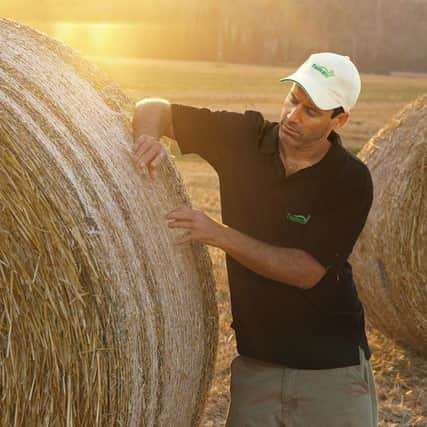Stress when baling can be caused in more ways than one


Since its introduction 30 years ago, netwrap has totally simplified the job of binding round bales, however if the tension settings are incorrect, this will have a huge impact on the performance of the net in the baler. This includes feeding into the baler, tightly binding the bale, full coverage of the bale and how cleanly the netwrap is cut, which is often overlooked.
Poorly cut netwrap can be attributed to the tension setter on the baler. The ragged tail handing inside the baler from a bad cut of netwrap has the potential to wrap around the feeding rollers during the next binding cycle causing all sorts of headaches and baling inefficiencies. Even more detrimental is if the net splits and separates with more than one piece of net coming off the roll and wrapping the feeding rollers. This unusual, but not uncommon problem, is more commonplace with traditional technology netwrap and is because of the way in which older netwrap is constructed.
Advertisement
Advertisement
Netwrap is made by knitting together many strands of thin, polyethylene tapes, each connected to their neighbour by thinner tapes. The type of stitch traditionally used in this older style netwrap is the same as that used in the production of ladies’ stockings, woollen pullovers and gents’ socks. As we know, laddering is caused when a loose thread is pulled, and the garment begins to unstitch. This unfortunate and costly problem is no longer a concern for users of TamaNet+ Netwrap, the familiar black and white zebra stripped netwrap.
Experts in netwrap, Tama identified this problem a few years ago and employed a different stitching method to eliminate this issue. If you’re still using standard, white netwrap, be careful.
Early signs of poor feeding or spreading of netwrap on the baler may be the clues to suspect there is something wrong with the baler set-up. So, what is the correct tension and how can it be checked?
Your first port of call should be to consult the baler operating manual; however, these tend to be vague or even misleading, and often the book can never be found. There is however a handy trick that will allow you to check tensions while in the field.
Advertisement
Advertisement
Before loading the roll of net, pull it tight lengthways in the direction it would feed into the baler – this will allow you to get the net tight. The pattern of the netwrap will look like rows of small triangles on their sides. Count the base of 10 of these triangles and measure the distance.
Begin baling and after making one or two bales, carry out the same process on the bale itself. Measure the base of 10 triangles on the bale in one or two places across its width, remembering to make sure you are measuring on net that is tight on the bale, and not the loose end of net on the bale. The measurement of 10 triangles on the bale should be 5–10% longer than the measurement taken on the roll, showing the net to have good and correct tension.
After measuring on the roll and the bale, if the two are similar, it clearly shows there is not enough tension being applied to the netwrap which could lead to the problems described above. On the other hand, if the measurement from the bale is found to be over 10% more than the measurement from the roll, the netwrap could be under too much tension, and risk net breaking on the bale if badly handled.
Different makes and models of baler have different ways of applying the tension to the net, but all can be adjusted to ensure correct operation.